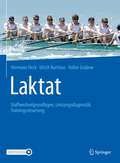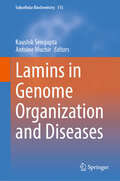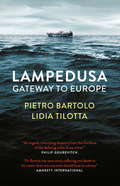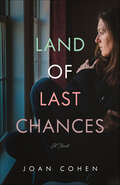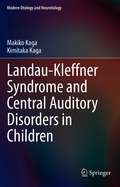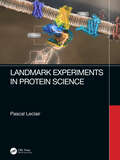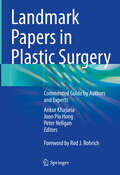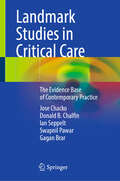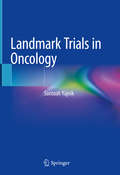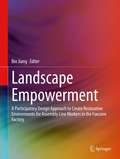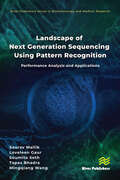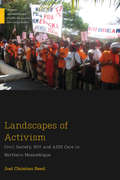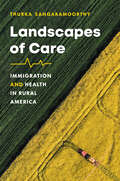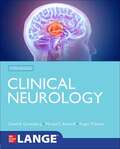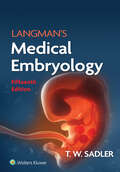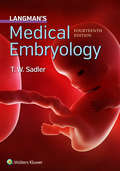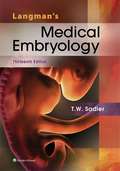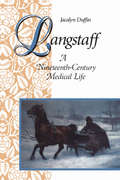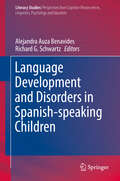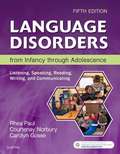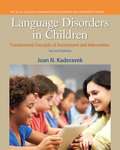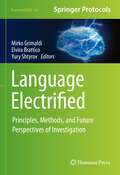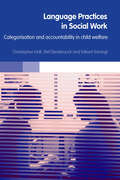- Table View
- List View
Laktat: Stoffwechselgrundlagen, Leistungsdiagnostik, Trainingssteuerung
by Hermann Heck Ulrich Bartmus Volker GrabowLaktat im Energiestoffwechsel und seine Nutzung in Leistungsdiagnostik und TrainingssteuerungDieses Buch widmet sich dem Thema Laktat in seinen verschiedensten Facetten. Es beschreibt neben einem historischen Abriss den Energiestoffwechsel des Muskels sowie ein Energiestoffwechselmodell, mit dem die meisten laktatbezogenen Phänomene erklärt werden können. Gängige Laktatanalysemethoden und Laktatschwellenkonzepte werden ebenso vorgestellt und kritisch diskutiert wie die zahlreichen Einflussfaktoren auf die Laktatleistungskurve (z. B. Testprotokoll, Vorbelastungen, Umgebungsbedingungen). Darüber hinaus wird der Einsatz von Laktat in der Leistungsdiagnostik und Trainingssteuerung – mit einem speziellen Fokus auf die Sportart Rudern – ausführlich thematisiert.Das Buch richtet sich an Sportmediziner und andere Ärzte, die leistungsdiagnostische Untersuchungen durchführen, sowie an Sportwissenschaftler, Trainer und an dem Thema interessierte Leistungs- und Breitensportler.
Lamins in Genome Organization and Diseases (Subcellular Biochemistry #115)
by Kaushik Sengupta Antoine MuchirThis new book covers the molecular biology of lamins, which are nuclear-derived intermediate filament proteins that play diverse roles in nuclear homeostasis, such as conferring structural rigidity to the nucleus and holding chromosomes together. Numerous mutations in the lamin type A protein give rise to a plethora of diseases called laminopathies affecting muscle, cardiac, adipose, and nervous tissues, and to a combination of all of them in the form of progeroid syndromes. Furthermore, the differential expression of lamins has been implicated in a wide variety of cancers. Over the past two decades, there has been an increasing number of interesting findings related to the perturbation of signalling cascades and transcriptome analysis in the pathogenesis of laminopathies. Few reports have also shed light on the epigenetic changes associated with these diseases. The rapid advancement of chromosome conformation capture methods has provided a new impetus to delineate the finer details of chromosome association with lamins at the topological level. Bringing together most of these exciting findings in a book that appeals to a broad readership of lamins and chromatin biology.
Lampedusa: Gateway to Europe
by Lidia Tilotta Dr Pietro Bartolo"Bartolo tells us about rescuing everyone he can, burying those he cannot, and saving their stories as if they were his own. This is a personal, urgent and universal book" GLORIA STEINEM"An urgent, wrenching dispatch from the frontline of the defining crisis of our times . . . Bartolo is at once the saviour and the coroner to boatload after boatload of migrants who risk everything to cross the deadly seas. It is also a damning indictment of the broader, collective indifference of humankind to both the drowned and the saved" PHILIP GOUREVITCH"Dr Pietro Bartolo has seen more suffering and death in his career than any one man should have to witness" Amnesty International"Through Bartolo we understand that it is impossible to do nothing in the face of such great human need" Vanity FairIt is common to think of the refugee crisis as a recent phenomenon, but Dr Pietro Bartolo, who runs the clinic on the Italian island of Lampedusa, has been caring for its victims - both the living and the dead - for a quarter of a century.Situated some 200 km off Italy's Southern coast, Lampedusa has hit the world headlines in recent years as the first port of call for hundreds of thousands of African and Middle Eastern migrants hoping to make a new life in Europe.The shipwrecks began in 1992. Before the Arab Spring, they came from Africa, but now they come from across the Arab world as well. And the death toll is staggering. On Christmas Eve, 1996, 286 bodies were recovered; on the night of October 3, 2003, 366 out of 500 migrants died after a shipwreck nearby.For the past twenty-five years, Doctor Bartolo has been rescuing, welcoming, helping, and providing medical assistance to those who survived. But, above all, he has been listening to them. Tales of pain and hope, stories of those who didn't make it, who died at sea, their bodies washed up on shore; stories of those who lost their loved ones, of babies that never had a chance to be born.SHORTLISTED FOR THE ITALIAN PROSE TRANSLATION AWARD (IPTA)Translated from the Italian by Chenxin Jiang
Land of Last Chances: A Novel
by Joan CohenJeanne Bridgeton, an unmarried executive in her late forties, discovers life doesn’t begin and end on a spreadsheet when her expected menopause instead becomes an unexpected pregnancy. Though accomplished at managing risk professionally, Jeanne realizes her skills don’t extend to her personal life, where she has allowed the professional and the personal to become intertwined. She’s not even sure which of two men in her life is the father. Worse yet, a previously undisclosed family secret reveals that she may carry a rare hereditary gene for early-onset Alzheimer’s—and it’s too late to get genetic tests. This leaves Jeanne to cope with her intense fear of risk without the aid of the mountain of data she’s accustomed to relying upon. Wrestling with the question of whether her own needs, or those of her child, should prevail takes Jeanne on an intensely emotional journey—one that ultimately leads to growth and enlightenment.
Landau-Kleffner Syndrome and Central Auditory Disorders in Children (Modern Otology and Neurotology)
by Kimitaka Kaga Makiko KagaThis book addresses current topics concerning Landau-Kleffner Syndrome (LKS) and related central auditory disorders from the perspectives of epidemiology, diagnosis, genetics and clinical treatment. LKS is a rare childhood neurological disorder and manifests auditory agnosia as the central auditory verbal dysfunction. In many cases, LKS patients also suffer from epileptic seizures. The book is divided into two parts, the first of which outlines LKS from its historical background to clinical treatment. In turn, the second part examines current topics involving related central auditory disorders, for purposes of comparing them with LKS. The book offers a valuable resource for many specialists, such as pediatric neurologists, neuropsychologists, audiologists and epileptologists, with an interest in this field.
Landmark Experiments in Protein Science
by Pascal LeclairProteins are the workhorses of cells, performing most of the important functions which allow cells to use nutrients and grow, communicate among each other, and importantly, die if aberrant behavior is detected. How were proteins discovered? What is their role in cells? How do dysfunctional proteins give rise to cancers? Landmark Experiments in Protein Science explores the manner in which the inner workings of cells were elucidated, with a special emphasis on the role of proteins. Experiments are discussed in a manner as to understand what questions were being asked that prompted the experiments and what technical challenges were faced in the process; and results are presented and discussed using primary data and graphs. Key Features Describes landmark experiments in cell biology and biochemistry. Discusses the "How" and "Why" of historically important experiments. Includes primary, original data and graphs. Emphasizes biological techniques, that help understand how many of the experiments performed were possible. Documents, chronologically, how each result fed into the next experiments.
Landmark Papers in Plastic Surgery: Commented Guide by Authors and Experts
by Joon Pio Hong Ankur Khajuria Peter NeliganThere has been an exponential growth in the number of research papers published in recent decades in the field of Plastic & Reconstructive Surgery, making it difficult to identify the key papers that have truly changed practice in plastic surgery. This book provides readers with a concise reference source for the key papers that underpin contemporary surgical practice and covers all aspects of the specialty, with the content being helpful for both trainees and specialists to understand the scientific developments and pioneering surgeries that allow expert surgeons to practice as they currently do. By exploring the ground-breaking papers in Plastic Surgery, readers can gain insights into the evolution of the field and learn valuable lessons on how to innovate. For trainees preparing for board or exit exams, such as the FRCS (Plast), this book serves as an invaluable reference source and revision guide, providing access to key landmark studies. It presents over 50 key research studieson plastic surgery along with full analysis and additional commentaries from experts and world-renowned authority figures in Plastic Surgery. It provides a valuable perspective on why the study is important, constituting essential reading for busy professionals as well as trainees, residents and fellows, and surgeons studying for professional examinations while distilling all the literature into a compact guide on the must-know scientific articles.
Landmark Studies in Critical Care: The Evidence Base of Contemporary Practice
by Jose Chacko Swapnil Pawar Ian Seppelt Gagan Brar Donald B. ChalfinThe book is a curated collection of groundbreaking papers entrenched in evidence-based medicine to provide trainees and practitioners in critical care medicine with a handy tool for reference. This compilation highlights pivotal research papers that have significantly influenced clinical practice. The studies in this book are carefully selected based on a rigorous methodology and cover a wide range of critical topics. The studies present robust findings and offer guidance on improving clinical outcomes. Critical care medicine is a relatively new area of specialization and many contentious topics have been the focus of research over the years. In the contemporary era of evidence-based medicine, researchers continue to search for reliable evidence. Despite an abundance of research, few papers have truly shaped the landscape. The book presents an overview of critical care research that has significantly influenced the field and impacted clinical practice. These studies represent landmarks in the history of critical care medicine, spearheaded by leaders in their research. The book is designed to appeal to both trainees and practitioners in the field of critical care medicine.
Landmark Trials in Oncology
by Santosh YajnikThis book describes the evolution of treatment in oncology through the lens of approximately 250 landmark clinical trials. The well-designed clinical trial is essential to the practice of medicine. There is no field that has embraced or been transformed more by the clinical trial than oncology. Each primary cancer site has a remarkable story that can be told through clinical trials. For example, patients who presented decades ago with soft tissue sarcoma of the extremities would invariably undergo limb amputation. The landmark National Cancer Institute study by Rosenberg et al. randomized patients to limb sparing surgery followed by adjuvant radiation therapy compared with limb amputation. This study helped change the standard of care by allowing most patients to retain their functioning limbs with an improvement in quality of life and no compromise in overall survival. Such major clinical trials for common malignancies including breast, prostate, lung, gastrointestinal, genitourinary, and gynecologic cancers are discussed. Because oncology is multidisciplinary, this book should be of interest for radiation oncologists, surgeons, medical oncologists, and other physicians interested in learning more about the landmark trials that have shaped oncology.
Landscape Empowerment: A Participatory Design Approach to Create Restorative Environments for Assembly Line Workers in the Foxconn Factory
by Bin JiangThis book discusses essential strategies and approaches to creating mentally restorative environments for highly stressed and depressed workers at sweatshop factories. Drawing on the Foxconn factory in Longhua, China and an adjacent urban village as a sample site for research and design practice, the book employs a bottom-up and participatory process. The content is divided into two main parts, the first of which investigates economic, cultural, human rights, and environmental issues related to the electronic industry and urban village, providing in-depth research on various aspects, especially the working and living conditions for Foxconn workers. Based on these findings, the second part highlights potential landscape designs to address a range of issues, locations, and scales. The book’s goals are to provide a set of original methods for research and design practice in a complex social and economic context, and to raise awareness regarding the health, dignity and freedom of millions of workers.
Landscape of Next Generation Sequencing Using Pattern Recognition: Performance Analysis and Applications (River Publishers Series in Biotechnology and Medical Research)
by Loveleen Gaur Mingqiang Wang Saurav Mallik Soumita Seth Tapas BhadraThis book focuses on an eminent technology called next generation sequencing (NGS) which has entirely changed the procedure of examining organisms and will have a great impact on biomedical research and disease diagnosis. Numerous computational challenges have been brought on by the rapid advancement of large-scale next-generation sequencing (NGS) technologies and their application. The term ""biomedical imaging"" refers to the use of a variety of imaging techniques (such as X-rays, CT scans, MRIs, ultrasounds, etc.) to get images of the interior organs of a human being for potential diagnostic, treatment planning, follow-up, and surgical purposes. In these circumstances, deep learning, a new learning method that uses multi-layered artificial neural networks (ANNs) for unsupervised, supervised, and semi-supervised learning, has attracted a lot of interest for applications to NGS and imaging, even when both of these data are used for the same group of patients.The three main research phenomena in biomedical research are disease classification, feature dimension reduction, and heterogeneity. AI approaches are used by clinical researchers to efficiently analyse extremely complicated biomedical datasets (e.g., multi-omic datasets. With the use of NGS data and biomedical imaging of various human organs, researchers may predict diseases using a variety of deep learning models. Unparalleled prospects to improve the work of radiologists, clinicians, and biomedical researchers, speed up disease detection and diagnosis, reduce treatment costs, and improve public health are presented by using deep learning models in disease prediction using NGS and biomedical imaging. This book influences a variety of critical disease data and medical images.
Landscapes of Activism: Civil Society, HIV and AIDS Care in Northern Mozambique (Medical Anthropology)
by Joel Christian ReedAIDS activists are often romanticized as extremely noble and selfless. However, the relationships among HIV support group members highlighted in Landscapes of Activism are hardly utopian or ideal. At first, the group has everything it needs, a thriving membership, and support from major donors. Soon, the group undergoes an identity crisis over money and power, eventually fading from the scene. As government and development institutions embraced activist demands—decentralizing AIDS care through policies of health systems strengthening—civil society was increasingly rendered obsolete. Charting this transition—from subjects, to citizens, and back again—reveals the inefficacy of protest, and the importance of community resilience. The product of in-depth ethnography and focused anthropological inquiry, this is the first book on AIDS activists in Mozambique. AIDS activism’s strange decline in southern Africa, rather than a reflection of citizen apathy, is the direct result of targeted state and donor intervention.
Landscapes of Care: Immigration and Health in Rural America (Studies in Social Medicine)
by Thurka SangaramoorthyThis insightful work on rural health in the United States examines the ways immigrants, mainly from Latin America and the Caribbean, navigate the health care system in the United States. Since 1990, immigration to the United States has risen sharply, and rural areas have seen the highest increases. Thurka Sangaramoorthy reveals that that the corporatization of health care delivery and immigration policies are deeply connected in rural America. Drawing from fieldwork that centers on Maryland's sparsely populated Eastern Shore, Sangaramoorthy shows how longstanding issues of precarity among rural health systems along with the exclusionary logics of immigration have mutually fashioned a "landscape of care" in which shared conditions of physical suffering and emotional anxiety among immigrants and rural residents generate powerful forms of regional vitality and social inclusion. Sangaramoorthy connects the Eastern Shore and its immigrant populations to many other places around the world that are struggling with the challenges of global migration, rural precarity, and health governance. Her extensive ethnographic and policy research shows the personal stories behind health inequity data and helps to give readers a human entry point into the enormous challenges of immigration and rural health.
Lange Clinical Neurology
by David Greenberg Michael J. Aminoff Roger P. SimonThe clearest, most concise coverage of one of the most complex topics in medicine―updated with the latest advances in the field <p><p>Clinical Neurology, Eleventh Edition, provides a comprehensive overview of basic and clinical neurology in a concise, digestible format. It links clinical neuroscience to current approaches for accurately diagnosing and effectively treating neurologic disorders. Covering all the advances in molecular biology and genetics, this popular guide emphasizes history-taking and neurologic examination as the cornerstones of diagnosis. All information is thoroughly up-to-date and presented as a practice-oriented approach to neurology based on the patient's presenting symptoms or signs.
Langman's Medical Embryology
by T. W. SadlerConcise, clearly written, and vibrantly illustrated, Langman’s Medical Embryology, 15th Edition, makes complex embryology concepts approachable to help you build the clinical understanding essential to your success in medical practice, nursing, or other health professions. Hundreds of full-color illustrations clarify the stages of embryonic development with rich detail, and engaging learning features, clinical examples, and online review questions ready you for the challenges ahead on your exams and in clinical practice.
Langman's Medical Embryology (Langman's Medical Embryology Ser.)
by T. W. SadlerPublisher's Note: Products purchased from 3rd Party sellers are not guaranteed by the Publisher for quality, authenticity, or access to any online entitlements included with the product. Vibrantly illustrated with full-color diagrams and clinical images, Langman's Medical Embryology, Fourteenth Edition helps medical, nursing, and health professions students confidently develop a basic understanding of embryology and its clinical relevance. Concise chapter summaries, captivating clinical correlates boxes, clinical problems, and a clear, concise writing style make the subject matter accessible and engaging to students throughout their courses.
Langman's Medical Embryology (Langman's Medical Embryology Ser.)
by T. W. SadlerPublisher's Note: Products purchased from 3rd Party sellers are not guaranteed by the Publisher for quality, authenticity, or access to any online entitlements included with the product. Vibrantly illustrated with full-color diagrams and clinical images, Langman's Medical Embryology, Fourteenth Edition helps medical, nursing, and health professions students confidently develop a basic understanding of embryology and its clinical relevance. Concise chapter summaries, captivating clinical correlates boxes, clinical problems, and a clear, concise writing style make the subject matter accessible and engaging to students throughout their courses.
Langman’s Medical Embryology, Thirteenth Edition
by T. W. SadlerLangman's Medical Embryology is organized into two parts. The first provides an overview of early development from gametogenesis through the embryonic period. Also included in this section are chapters on placental and fetal development as well as prenatal diagnosis and birth defects. The second part of the text provides a description of the fundamental processes of embryogenesis for each organ system.
Langstaff: A Nineteenth-Century Medical Life
by Jacalyn DuffinA unique and readable microhistory of an ordinary physician and his community during a period of revolutionary medical change. Duffin bases her insights on a detailed computer-assisted analysis of 40 years of extant daybooks of James Langstaff (1825-1889).
Language Development and Disorders in Spanish-speaking Children
by Richard G. Schwartz Alejandra Auza BenavidesProminent researchers from the US, Mexico, Chile, Colombia and Spain contribute experimental reports on language development of children who are acquiring Spanish. The chapters cover a wide range of dimensions in acquisition: comprehension and production; monolingualism and bilingualism; typical development, children who are at risk and children with language disorders, phonology, semantics, and morphosyntax. These studies will inform linguistic theory development in clinical linguistics as well as offer insights on how language works in relation to cognitive functions that are associated with when children understand or use language. The unique data from child language offer perspectives that cannot be drawn from adult language. The first part is dedicated to the acquisition of Spanish as a first or second language by typically-developing children, the second part offers studies on children who are at risk of language delays, and the third part focuses on children with specific language impairment, disorders and syndromes.
Language Disorders from Infancy through Adolescence: Listening, Speaking, Reading, Writing, and Communicating
by Rhea Paul Courtenay Norbury Carolyn GosseSpanning the entire childhood developmental period, Language Disorders from Infancy Through Adolescence, 5th Edition is the go-to text for learning how to properly assess childhood language disorders and provide appropriate treatment. The most comprehensive title available on childhood language disorders, it uses a descriptive-developmental approach to present basic concepts and vocabulary, an overview of key issues and controversies, the scope of communicative difficulties that make up child language disorders, and information on how language pathologists approach the assessment and intervention processes. This new edition also features significant updates in research, trends, social skills assessment, and instruction best practices.
Language Disorders in Children: Fundamental Concepts of Assessment and Intervention
by Joan N. KaderavekThis text is more than an introductory look at language disorders. It goes beyond basic concepts and basic definitions to teach students how to analyze, synthesize, evaluate, and link the information they are learning. It offers readers opportunities for higher-order learning, while preparing students to become careful evaluators of information, as well as adept problem solvers. Organized by disorder groups and theme, Language Disorders in Children, 2/e helps students easily make connections between theoretical information and clinical practice through a number of thoughtful features such as case histories, clinical decision trees, and hot topic discussions. It's an approach that meets the needs of today's students to learn lifetime critical thinking skills, to see relationships between isolated ideas and facts, and to think like a speech-language pathologist.
Language Electrified: Principles, Methods, and Future Perspectives of Investigation (Neuromethods #202)
by Elvira Brattico Mirko Grimaldi Yury ShtyrovLanguage, as a system we use to communicate, represents the brain’s biologically perfected machinery for converting thoughts (ideas, concepts, and reflections of both the outside world and our inner feelings) into words and sentences. Crucially, this process occurs in real time. How hundreds of billions of neurons within the dark of the skull control language and speech remains, in some respects, a mystery. To track such neural dynamics in time, we need to exploit physiological tools capable of following temporal patterns of neural activity on a fine-grain time scale. In parallel, it is necessary to begin to provide a real interdisciplinary academic background for scholars wishing to embark on this field of study. Unlike many similar efforts, this book has been conceived as a hands-on tool offering the reader the possibility to progressively acquire principles, techniques, and methods necessary to pursue interdisciplinary research in a fascinating field intersecting linguistic and neuroscience. It focuses on neurophysiological methods and applications useful to track the high speed and rapid temporal dynamics of neural activity involved in language and speech. The chapters in this book are organized into four parts. Part One discusses neural principles and tools for an effective approach to the field of investigation. Part Two looks at the issues and perspectives concerned with the use of a range of neurophysiological technologies to investigate the neural computations of language and speech processes. Part Three focuses on an in-depth exploration of the neural processes associated with the main types of linguistic information, ranging from phonemes and prosody to syntax, pragmatics, and figurative language. Lastly, Part Five explores the phenomena that goes beyond the segments of basic linguistic units. In the Neuromethods series style, chapters include the kind of detail and key advice from the specialists needed to get successful results in your laboratory Cutting-edge and thorough, Language Electrified: Principles, Methods, and Future Perspectives of Investigation is a valuable resource that offers the necessary tool-box for all researchers and scientists interested in the challenging field of the neurophysiology of language and speech.
Language Learning in Children Who Are Deaf and Hard of Hearing: Multiple Pathways
by Susan R. Easterbrooks Sharon BakerThis book addresses the language development process from multiple perspectives, drawing on the latest research in bilingual biculturalism, cochlear implant technology and neuroscience. The book presents a unique view of language development, proposing that there are multiple pathways to the acquisition of a system of communication. For parents and educators working with deaf and hard of hearing children.
Language Practices in Social Work: Categorisation and Accountability in Child Welfare
by Srikant Sarangi Christopher Hall Stefaan SlembrouckAnalysis of language and discourse in social sciences has become increasingly popular over the past thirty years. Only very recently has it been applied to the study of social work, despite the fact that communication and language are central to social work practice. This book looks at how social workers, their clients and other professionals categorise and manage the problems of social work in ways which are rendered understandable, accountable and which justify professional intervention. Features include: studies of key practice areas in social work, such as interviews, case conferences, home visits analysis of the language and construction used in typical case studies of everyday social work practice exploration of the ways in which professionals can examine their own practice and uncover the discursive, narrative and rhetorical methods that they use. The purpose of this engaging study is to increase awareness of language and discourse in order to help develop better practice in social work. It is essential reading for professionals in social work, child welfare and the human services and will be a valuable contribution to the study of professional language and communication.
